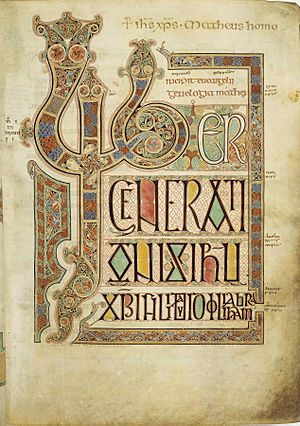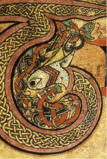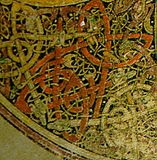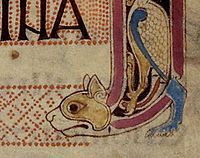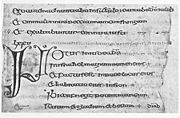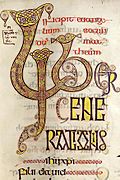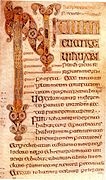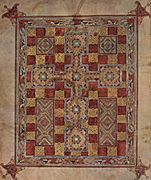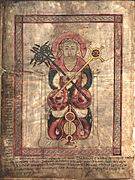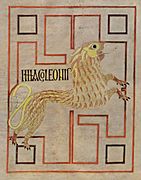Insular illumination facts for kids
Insular illumination is a special type of art found in old books, called illuminated manuscripts. These books were made in monasteries in Ireland and Great Britain between the 500s and 800s AD. This art style also spread to monasteries in Europe that were influenced by these British and Irish monks.
This art is known for its unique look. It often uses designs inspired by metalwork, lots of interlacing (patterns that weave over and under each other), and beautiful handwriting (calligraphy). The most famous books from this time are usually gospel books, which contain parts of the Christian Bible. We know of about sixty such manuscripts from this period.
Contents
How Insular Illumination Started and Spread
The Insular artistic style began after St Patrick helped bring Christianity to Ireland in the 4th and 5th centuries AD. New religious groups, mostly monasteries, started ordering many artworks. These included special objects for church services, clothes for priests, and, of course, manuscripts.
Two main types of manuscripts were popular:
- Small gospel books: These were used by preachers and missionaries, or for private prayer. Examples include the Book of Dimma and the Book of Mulling.
- Large books: These were kept for important church services in the monasteries. The Book of Kells is a great example of this type.
Spreading the Art to Britain
Irish monks played a big part in spreading Christianity to Scotland and northern Great Britain. They set up many monasteries, like Iona Abbey in Scotland, founded by Columba in 563. Another important one was Lindisfarne, started by Aidan in Northumbria in 635. These Irish missionaries brought their unique art style to Britain along with their religion.
During the 6th and 7th centuries, especially after the Gregorian mission from Rome, southern Britain also started to be influenced by Christianity from mainland Europe, mainly Italy. Some Italian and Byzantine (from the Eastern Roman Empire) manuscripts arrived in Britain. These also helped shape the Insular illumination style.
The main places where these books were made were first in Northumbria, then later in southern England and Kent during the 7th and 8th centuries. Monasteries in these areas often had more money and support from Anglo-Saxon kings than those in Ireland. The writing and art workshops (called scriptoria) at Lindisfarne and Iona were very busy at the end of the 8th century.
Spreading the Art to Europe
At the end of the 7th century, several Irish missionaries, led by Columbanus, traveled to Europe. They helped create new monasteries in France, Switzerland, and northern Italy. For example, Columbanus's student, Saint Gall, helped found an abbey in Switzerland. Also, St Kilian of Würzburg worked in southern Germany.
All these new monasteries helped spread Insular calligraphy (fancy writing) and decorative techniques to manuscripts made in Europe. Books made in northern France during the Carolingian period (around the 8th and 9th centuries) often show a clear Insular influence. This style is sometimes called "Franco-Saxon".
What Makes Insular Illumination Special?
Even though these manuscripts came from many different places, they share several common features.
Preparing the Parchment
The animal skin used for the pages, called parchment, was treated in a special way. It was made to feel a bit like suede, which meant it absorbed ink and colors very well. This special treatment allowed for both beautiful writing and detailed decorations.
Ornamental Motifs (Patterns)
The interlace pattern is the most famous design in Insular art. This decoration involves ribbons or lines that weave over and under each other, creating complex knots and patterns. While interlace can be found in other art styles, it was used almost everywhere in Insular manuscripts from the mid-7th century onwards. It could fill spaces around letters, frames, margins, and even entire pages called carpet pages. There were different types of interlace, like simple, double, or triple weaves.
Other patterns included:
- Straight-line patterns: These featured diamonds, checkerboard designs, and zig-zag lines (like Greek frets).
- Round patterns: These included circles, spirals, and winding helix shapes.
Zoomorphic motifs are animal designs. These animals often stretch out into the interlace patterns. Their heads might be at one end of a pattern, and sometimes their tail or rear end would appear at the other. In earlier manuscripts, the animals looked very simple, making it hard to tell what kind they were. But in later books, like the Lindisfarne Gospels, animals like dogs and predators started to look more realistic. These designs might have been popular because Anglo-Saxon kings enjoyed hunting.
-
A close-up from the Book of Kells, showing weaving patterns and an animal-like spiral.
-
A cat-like decoration from the Lindisfarne Gospels.
Decorated Initials
The Cathach of St. Columba, made in the early 7th century, is the oldest existing manuscript with decorated initials in the Insular style. An initial is the very first letter of a section or chapter. In these books, the first letter was made very large and decorated. The letters that followed it would then gradually get smaller until they reached the normal size of the main text.
These initials were decorated with curves, spirals, dots, and even animal heads. This kind of decoration was also seen in Celtic art from earlier times (like the La Tène culture). This unique initial style really set Insular manuscripts apart from older Roman-style books.
-
An initial from the Cathach of St. Columba.
-
A close-up of an initial from the Echternach Gospels.
-
The start of the Gospel of Mark in the Book of Durrow.
Miniatures (Small Pictures)
The earliest pictures, or miniatures, in Insular manuscripts were often simple images of a cross. Sometimes these crosses were part of a full-page design called a carpet page. Pictures of people probably only started appearing because of influences from books brought over from Europe.
Experts have noticed that some details in these early miniatures are similar to ancient manuscripts from Persia. These might have arrived in Britain from people who went on pilgrimages to the Near East. The human figures in these pictures are often very simple. They usually show people standing, often the Evangelists (writers of the Gospels), but without wings or a halo (a circle of light around their head). Sometimes, instead of a full person, only their symbols are shown, like a lion, cow, eagle, or man, arranged like a coat of arms.
-
A cross design on a carpet page in the Lindisfarne Gospels.
-
A picture of St Luke from the Lichfield Gospels.
-
The lion, which is the symbol for St Mark, from the Echternach Gospels.
See also


